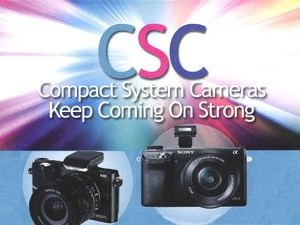
Well, we’ve finally settled on a name for those fetchingly compact interchangeable-lens cameras that provide something akin to the shooting experience and optical flexibility of digital SLRs, but with noticeably more compact, lightweight form factors.
So good-bye “mirrorless compacts,” “ILCs,” “EVILs” and “CILCs”—and welcome to the wild, wonderful world of the Compact System Camera (CSC). As this rapidly emerging category continues to strut its stuff on this side of the Pacific pond (it’s already pretty well established in Japan), certain trends are now clearly evident. The majority of these cameras now sport electronic viewfinders (EVFs), both conventional and OLED, in addition to LCD or OLED monitors, making the transition from DSLR to CSC easier than ever for serious shooters.
Another plus factor is the ability to press your existing DSLR lenses into service on these compact bodies, possible, for example, on the Canon M and Sony NEX models via relatively inexpensive adapters. The majority of CSCs use APS-C or Micro Four Thirds sensors, but Nikon and Pentax both offer deliciously small, stylish CSCs based on the smaller CX and 1/2.3-inch formats, respectively, which also result in exquisitely small, lightweight lenses and a complete system you can literally carry in a jacket pocket or handbag.
From a dealer perspective, CSCs cut two ways. Full-featured, enthusiast-aimed models would seem to compete head-to-head with DSLRs, but while that can happen, the stats show that most high-end CSC buyers already own a complete DSLR system—go figure! In other words, they opt for a CSC as their casual “sports car” camera while their DSLR is their “SUV” or maybe “sports sedan.” If you think this scenario describes the guy or gal in front of your counter, it makes sense to display and demonstrate models that allow them to use their DSLR’s optical arsenal by acquiring a compact adapter.
On the other hand (and this is the idea behind the elegantly petite Nikon 1 cameras and the cute Pentax Q10), CSCs are ideal step-up cameras for point-and-shoot photographers and emerging enthusiasts who want to extend their shooting range with interchangeable lenses but value convenience above all—and who want to travel light.
No matter how you look at it, most CSCs are beautiful objects that take great pictures and are engaging and fun to shoot with. In short, they definitely fit in with today’s active lifestyle consumers. Here are some of the coolest and latest models.
Canon EOS-M
Canon has finally taken the plunge, entering the mirrorless interchangeable-lens camera fray with this sleek, stylish beauty incorporating what may be the same high-performance 18MP APS-C-format CMOS sensor used in the very successful EOS Rebel T4i. It employs Canon’s latest Digic 5 image processor and uses Hybrid CMOS AF that combines contrast- and phase-detection AF, a system claimed to deliver enhanced accuracy and speed. Other key features include: a very-high-res 3.0-inch touch screen LCD with touch AF and multi-touch operation; Full HD 1080p movie capability; ISO 100–12,800 settings, expandable to ISO 25,600; and a burst rate of 4.3 frames per sec for up to 17 shots with a UHS-1 card. Significantly, the new EOS-M is compatible with Canon EF and EF-S DSLR lenses using an adapter, vastly extending its optical range. $799.99 with EF-M 22mm f/2 STM lens. usa.canon.com
Sony NEX-6
Offering many of the features of the top-of-the-line NEX-7, such as a built-in XGA resolution OLED EVF and a 10-fps burst rate, this attractively priced 16.1MP APS-C-format beauty delivers fast, responsive shooting and focus tracking using a unique “Fast Hybrid AF” system with on-sensor phase-detection AF. In addition to shooting RAW and JPEG stills, it records Full HD 1,920×1,080 video in 60p, 60i or cinematic 24p with full-time AF, using a new Quick Navi control system for selecting modes and creative options. Other features include: a 3.0-inch 921k-dot LCD; built-in Wi-Fi; a pop-up flash; ISO 3200, extendable to 25,600; Clear Image digital zoom; auto HDR and sweep panorama modes; D-Range Optimizer; and six-image layering. It also supports Sony’s PlayMemories Camera Apps. $999.99 with retractable Sony 16–50mm f/3.55.6 lens with electrically driven zoom.
Additionally, Sony’s NEX-7 boasts a 24.3MP sensor and tilt/swing LCD ($1,249.99); while the NEX-5R uses a 16.1MP sensor, a tiltable 3.0-inch touch screen and built-in Wi-Fi ($559.99). Both come with 18–55mm lenses. sony.com
Fujifilm X-E1
Combining sleek rangefinder styling with DSLR functionality, the new X-E1 employs a 16MP APS-C X-Trans CMOS sensor that uses a unique color filter pixel array designed to eliminate the need for a low pass filter, reduce moiré and false colors, enhance color realism and reduce noise. The camera also uses an X-series mount with a 10-pin data bus for more efficient information transfer. Other features include: a 2.36-million-dot OLED EVF; a 2.8-inch LCD monitor; a focal-plane shutter; Full HD 1080p video capture with film simulation modes; JPEG & RAW capture; auto bracketing and dynamic range bracketing; and a magnesium alloy body. $1,399.95 with XF 18–55mm f/2.8–4 OIS lens.
A companion model to the X-E1, the Fujifilm X-Pro 1 has a similar body style and hybrid multi viewfinder ($1,399.95 body only). fujifilmusa.com
Samsung NX210
Inside its striking minimalist, ergonomically contoured body, this mirrorless compact employs a big 20.3MP APS-C sensor and incorporates a 3.0-inch full-information AMOLED display with VGA resolution that provides a much greater dynamic contrast range and faster response than a conventional LCD. Other key features include: Full HD 1080p video capability at 30 fps; ISO settings to 12,800; a maximum still picture framing rate of 8 fps; preview capability to display the results of different camera settings; 2D/3D panorama shooting; Wi-Fi connectivity; and Samsung’s i-Function lens control with a button on the lens that unlocks the manual adjustment of key settings, including shutter speed, aperture, white balance and ISO. $749.99 body only.
Other 20.3MP cameras in Samsung’s NX line include: the NX20 ($899.99) and the NX1000 ($499), both providing Full HD 1080p video capture. samsung.com
Nikon 1 V2
Nikon’s newly released 1 V2 takes the CX-format (13.2×8.8mm) compact line to a new level of performance and functionality that is clearly aimed at serious enthusiasts seeking a compact, lightweight alternative to a DSLR. Its CMOS sensor has been upgraded to 14.2MP (from the 1 V1’s 10.1MP), the controls have been reconfigured to be more intuitive and DSLR-like with a PSAM mode dial, and a new enhanced Expeed 3A processor enables full-res RAW capture at a blistering 15 fps with continuous AF, and 60 fps with one-time AF. Like the V1, the V2 employs an advanced hybrid AF system with 73 phase-detect points on-sensor plus 135-point contrast AF for ultrafast focusing and full-time AF when shooting 1,920×1,080 Full HD video. Other features include: a 3.0-inch, 921k-dot LCD; live-image preview; a 1.44-million-dot (SVGA) electronic viewfinder; slow-view mode that slows down the moment while it’s happening; built-in Wi-Fi connectivity with optional adapter; and an i-TTL hot shoe. $899.95 with 1 Nikkor VR 10–30mm f/3.5–5.6 lens. nikonusa.com
Olympus OM-D E-M5
The flagship of the Olympus Micro Four Thirds-system lineup, it delivers a DSLR shooting experience in a camera that’s exceptionally compact and light yet offers an array of cutting-edge performance and convenience features. These include a 16MP Live MOS sensor and a built-in, ultra-high-definition eye-level electronic viewfinder that provides a bright, detailed 100% view, an astonishing 120-fps refresh rate and instant automatic switching between the EVF and the 3.0-inch, high-res, tilting touch-screen OLED monitor. A unique 5-Axis sensor-shift image-stabilization (IS) system is designed to deliver sharp, shake-free still images and 1,920×1,080 Full HD video, and its advanced TruPic VI image processor pushes image data off the sensor at an incredible 240 fps for fast AF tracking, 3D tracking and an impressive 9-fps burst rate. Other features include: RAW + JPEG capture; 11 Art filters; multiple exposure mode; ISO 25,600; and a rugged, dustproof, weatherproof magnesium alloy body. $1,199.99 body only. olympusamerica.com
Pentax Q10
With a sexier, more fashionable form factor and an updated 12.4MP 1/2.3-inch backlit CMOS sensor, the ultracompact, lightweight Q10 is claimed to deliver more responsive operation and improved AF performance. Other features follow closely to those of its illustrious cult-classic predecessor, the Pentax Q ($345.95 with 5–15mm normal lens) that remains in the line. These include: a 460k-dot, 3.0-inch LCD monitor; RAW & JPEG file formats; 5-fps burst; Full HD 1080p video capture at 30 fps; built-in sensor-shift shake reduction; a customizable quick dial that can be assigned a variety of creative modes, smart effect options or camera settings; a pop-up flash; face detection; focus tracking; and bokeh (background blur) control. $529.95 with 27.5–83mm equivalent lens. pentaximaging.com
Panasonic Lumix DMC-GH3
This intelligently upgraded successor to the much-admired Micro Four Thirds Lumix GH2 features a 16.05MP Digital Live MOS sensor coupled to a new 4-CPU Venus engine, which enables the GH3 to capture high-res JPEG and RAW files and Full HD 1080p video at 60p and cinematic 24p, as well as sensitivity settings that extend to ISO 25,600. It also features OLED displays for both the monitor and live-view EVF, full-area and pinpoint AF, auto HDR for still photos, electronic front and rear shutters, a built-in level, Wi-Fi connectivity, and 40%, 48% and 89% slow motion video modes. A revised button layout improves operational speed and convenience, and it’s all built into a tough, weather-sealed magnesium alloy body. $1,299.99 body only.
Other Panasonic Lumix CSC models include the GX1 (16MP, no EVF, $449) and the G5 (16MP, 1,440,000-dot live viewfinder, rotating LCD, $699.99). panasonic.com





